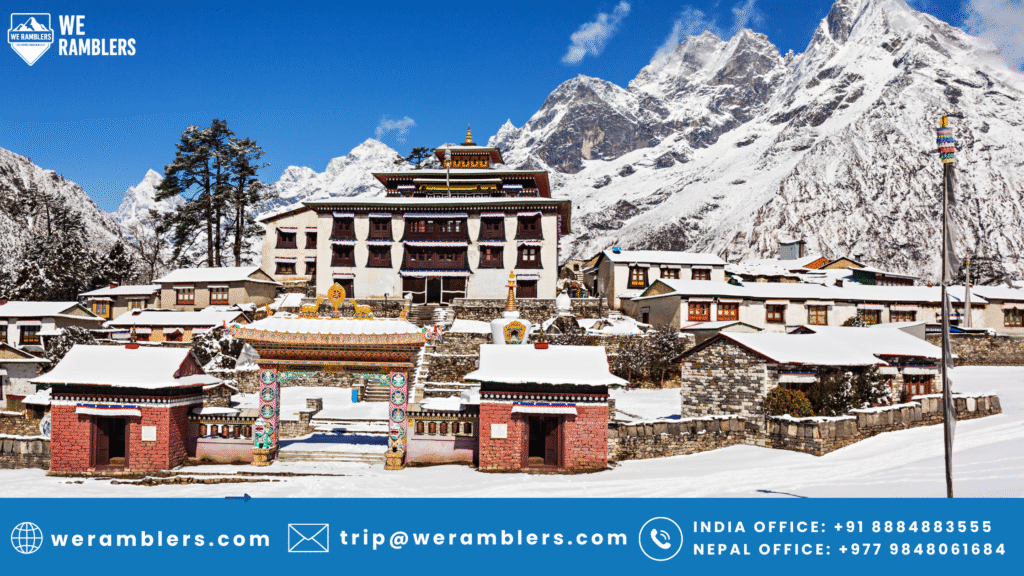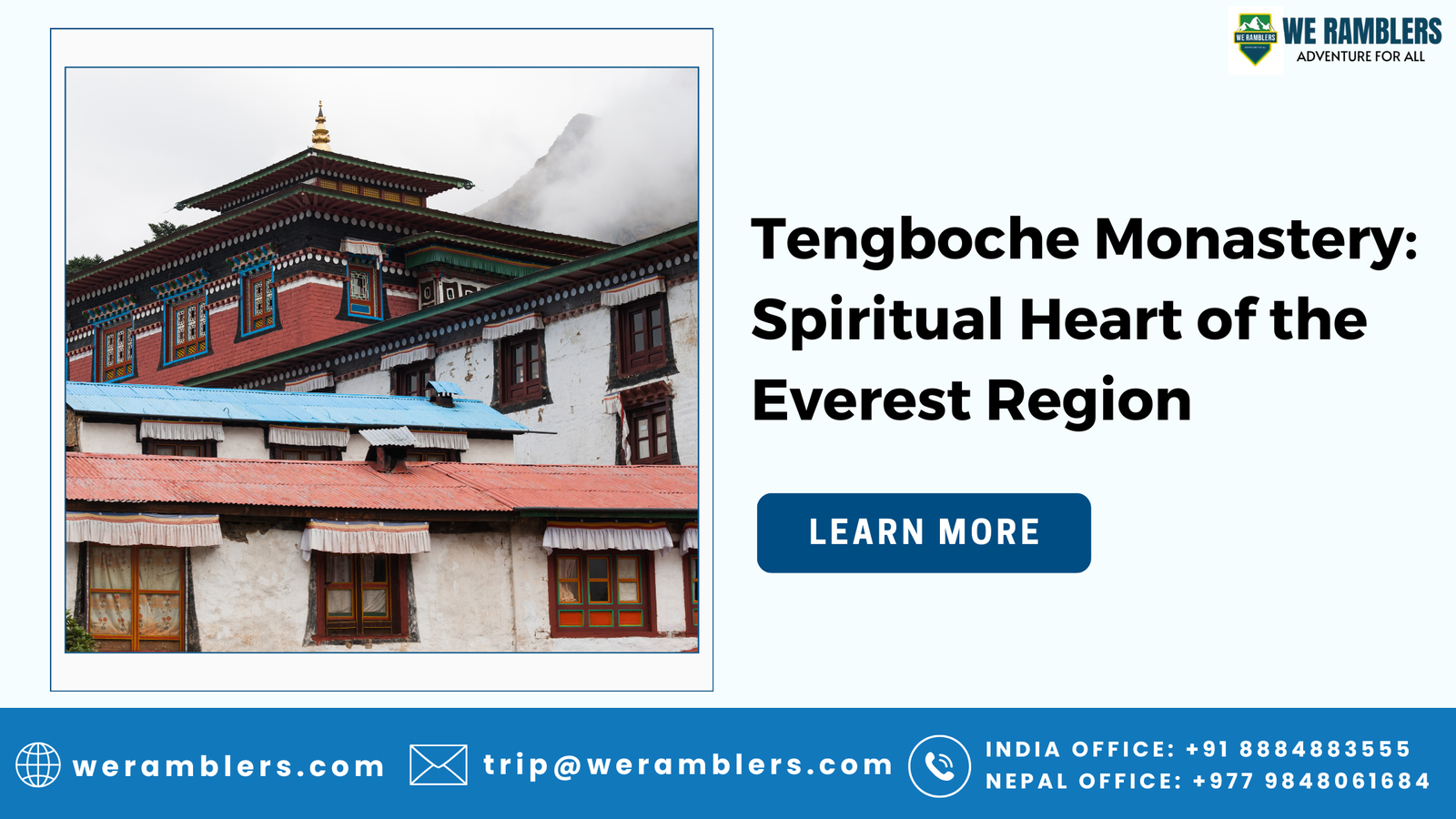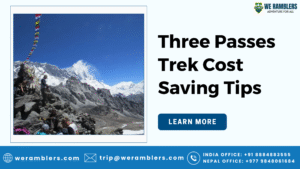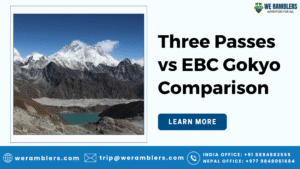Tengboche Monastery: Spiritual Heart of the Everest Region
Perched dramatically against the backdrop of towering Himalayan giants, Tengboche Monastery is more than just a pit stop along the Everest Base Camp trail; it is a sacred sanctuary where spirituality, culture, and nature converge. Located at 3,867 meters (12,687 feet), this iconic monastery is considered one of the most important religious sites in the Khumbu region, offering weary trekkers a rare moment of serenity amid the intensity of the mountains.
Whether you’re drawn by its architectural beauty, intrigued by Sherpa Buddhism, or inspired by the panoramic views of Ama Dablam, Everest, and Lhotse, Tengboche Monastery promises a deeply enriching experience. It’s a place where chanting monks echo through the pine-scented air, prayer flags flutter with the wind, and centuries-old traditions remain alive.
Where is Tengboche Monastery Located?
Tengboche Monastery is situated in Tengboche village, a small but spiritually significant settlement in the Khumbu region of northeastern Nepal. It’s nestled within the Sagarmatha National Park, a UNESCO World Heritage Site, home to many species of Himalayan flora and fauna.
Surrounded by majestic peaks like Ama Dablam, Thamserku, and Everest, Tengboche offers a surreal mountain amphitheater that makes it one of the most scenic monastery locations in the world. Due to its location on the Everest Base Camp trekking route, it attracts thousands of trekkers every year seeking not only adventure but also spiritual inspiration.
History and Spiritual Significance of Tengboche Monastery
Founded in 1916 by Lama Gulu, Tengboche Monastery is rooted in the Nyingmapa tradition, the oldest school of Tibetan Buddhism. Over the years, it has survived natural disasters, including a devastating earthquake and a fire in 1989, after which it was painstakingly rebuilt with international support.
The monastery is a spiritual hub for the Sherpa people, hosting numerous festivals and ceremonies throughout the year. Its central location and influence make it a cultural cornerstone for the entire Khumbu Valley.
Most notably, the monastery plays a pivotal role during the annual Mani Rimdu Festival, a vibrant event marked by masked dances, sacred chants, and blessings that symbolize the triumph of good over evil. The event draws both locals and trekkers alike, offering an unforgettable spiritual immersion in the high Himalayas.
Trekking to Tengboche Monastery: A Journey for the Soul
Visiting Tengboche isn’t just about reaching a destination; it’s a pilgrimage through the Himalayas. Most visitors arrive at Tengboche while trekking to Everest Base Camp (EBC), following the classic route:
Lukla → Phakding → Namche Bazaar → Tengboche
From Namche Bazaar, the trail ascends steadily through rhododendron forests, suspension bridges, and alpine terrain before revealing the first breathtaking view of Tengboche Monastery against the Himalayan backdrop.
The trek from Namche to Tengboche typically takes 4–5 hours, with a steep climb toward the end that rewards you with spiritual silence and 360-degree views of snow-capped peaks.
Permits required for this trek include:
- Sagarmatha National Park Entry Permit
- TIMS (Trekkers’ Information Management System) Card
Note: As of 2023, all foreign trekkers must be accompanied by a certified guide, ensuring both safety and adherence to Nepal’s latest trekking regulations.
The Architecture and Daily Life at Tengboche Monastery
Built in traditional Tibetan architectural style, Tengboche Monastery stands as a majestic two-story structure adorned with colorful murals, intricate woodwork, and sacred symbols. The main prayer hall houses a giant seated statue of Sakyamuni Buddha, surrounded by ancient Thangka paintings, scrolls, and scriptures.
Visitors can witness daily prayer rituals, where monks chant ancient mantras, ring bells, and offer incense, creating a meditative atmosphere that transcends language and culture. The monastery is home to about 30 monks, including novices who are trained in Buddhist philosophy, ritual practices, and meditation.

Mani Rimdu Festival at Tengboche Monastery
One of the most anticipated events in the region, the Mani Rimdu Festival is celebrated over 19 days in October or November, depending on the lunar calendar. The festival represents the spread of Buddhism from Tibet to Nepal, and its culmination at Tengboche includes:
- Chham (masked dances) by monks in elaborate costumes
- Rituals for world peace and spiritual protection
- Public blessings by the Rinpoche
- Traditional music and incense ceremonies
If you’re planning a trek around this time, witnessing Mani Rimdu at Tengboche is a once-in-a-lifetime cultural experience not to be missed.
Scenic Highlights Around Tengboche
Tengboche’s setting offers unrivaled panoramic views of the Himalayan range. Mount Ama Dablam, with its elegant pyramid shape, dominates the skyline and is often referred to as the “Matterhorn of Nepal.” You can also see Everest, Lhotse, Thamserku, and Kangtega from the monastery grounds.
Nearby attractions include:
- Debuche Village – a peaceful hamlet with a nunnery
- Pangboche – home to another historic monastery
- Dingboche – a common acclimatization stop for trekkers
The sunrise and sunset views from Tengboche are particularly awe-inspiring, making it a favorite spot for photographers and pilgrims alike.
We Ramblers — Your Adventure Trekking Partner
We Ramblers is a leading adventure travel company offering expert-guided treks across the Himalayas, including Everest Base Camp, Langtang Valley, Khopra Ridge, Mardi Himal, and more. With a focus on sustainable, safe, and immersive trekking experiences, our team ensures you travel with a certified guide, as required by Nepal’s latest regulations.
We curate journeys that go beyond the trail, integrating cultural discovery, local interaction, and spiritual exploration, just like the serene experience at Tengboche Monastery.
Frequently Asked Questions (FAQs) About Tengboche Monastery
Q1: How do I reach Tengboche Monastery?
To reach Tengboche, fly from Kathmandu to Lukla, then trek through Phakding and Namche Bazaar. The trail from Namche to Tengboche takes about 4–5 hours.
Q2: Can you stay overnight in Tengboche?
Yes, there are a few teahouses and lodges near the monastery where trekkers can stay overnight. Rooms are basic but offer stunning views.
Q3: What is the best time to visit Tengboche Monastery?
The ideal seasons are pre-monsoon (March–May) and post-monsoon (September–November). October–November is best if you wish to witness the Mani Rimdu Festival.
Q4: What altitude is Tengboche Monastery?
Tengboche Monastery is located at an elevation of 3,867 meters (12,687 feet).
Q5: Is Tengboche part of the Everest Base Camp trek?
Yes, it is one of the key stops on the Everest Base Camp trek itinerary, often used for acclimatization and cultural enrichment. Contact us now to get the full details.





